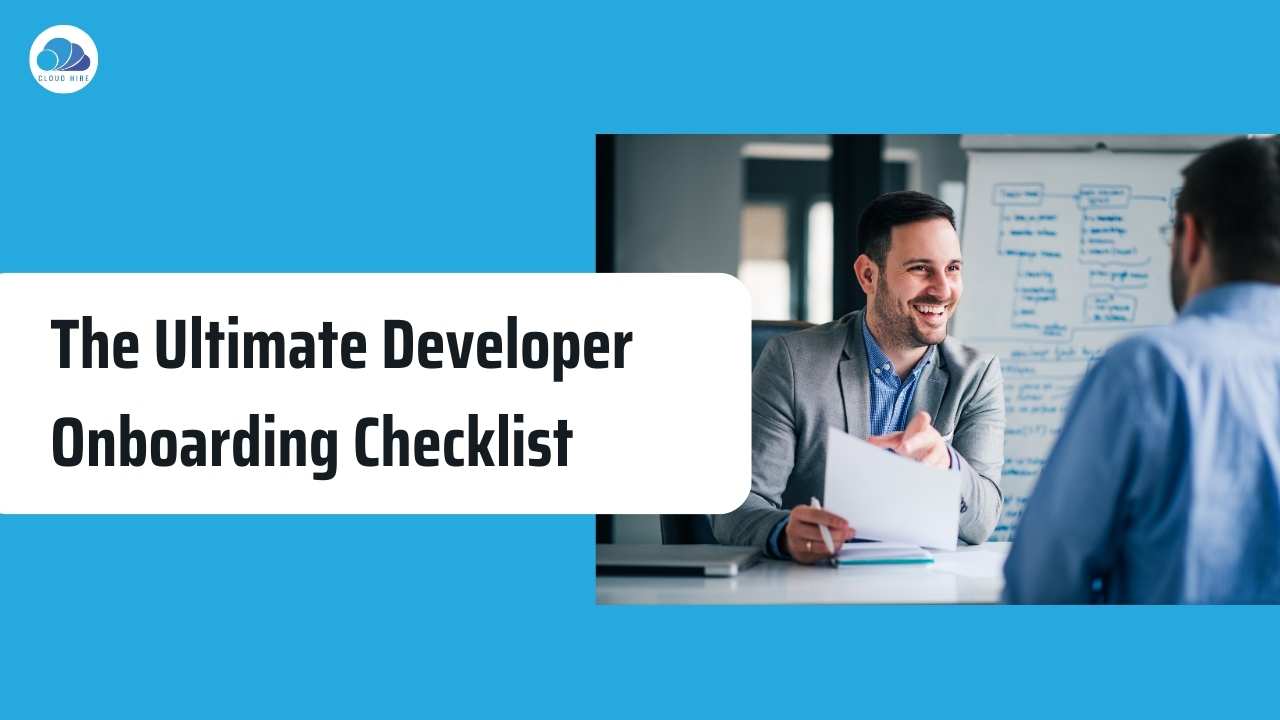Hiring and onboarding new developers is a crucial step in scaling your startup or business. However, without a well-structured plan in place, you may struggle to retain top talent and maximize their productivity. Reports indicate a strong onboarding process boosts employee retention by 82% and productivity by more than 70%.
As a leading full-time virtual employee (FTVE) provider and onboarding company, we’ve taken the time to compile this comprehensive developer onboarding checklist to ensure a seamless and successful onboarding process. From pre-onboarding to the first 90 days, we’ll cover all the essential steps and best practices to make your new developers feel welcome, supported, and motivated.
What Is Developer Onboarding?
Developer onboarding is a crucial aspect of integrating new software developers into an existing team. It goes beyond simply providing them with the necessary tools and resources. The process involves familiarizing new developers with the team’s workflows, processes, and tools, enabling them to contribute effectively to projects.
By providing comprehensive training and support, developer onboarding ensures that new team members are equipped with the knowledge and skills needed to hit the ground running. This seamless integration not only boosts productivity but also fosters a sense of belonging and camaraderie within the team, as we’ll observe below.
The Importance of Developer Onboarding
Effective developer onboarding is crucial for 3 big reasons:
- First, it sets the tone for the developer’s experience in your company, influencing their engagement, productivity, and overall satisfaction. According to BambooHR, 89% of employees who receive effective onboarding feel “engaged” at work and are 30 times more likely to feel job satisfaction.
- Second, a well-structured developer onboarding process ensures that developers understand your business goals, values, and expectations, aligning their work with your vision. New hires who receive a positive onboarding experience claim they’re 3 times more likely to be strongly committed to their employer.
- Finally, a comprehensive onboarding checklist helps developers quickly acclimate to your company’s workflows, tools, and culture, reducing ramp-up time and optimizing their contributions. Employees who pass through a formal onboarding program have been found to have 62% higher productivity.
However, to ensure your remote developer hires enjoy these benefits, it’s important to adhere to certain best practices when conducting the developer onboarding process.
5 Developer Onboarding Best Practices

To enhance the onboarding experience, consider implementing the following best practices:
- Provide a welcome package.
- Assign a buddy or mentor.
- Establish clear goals and milestones.
- Conduct regular check-ins.
- Encourage continuous learning.
1. Provide a Welcome Package.
Create a welcome package that includes essential information about your company, its mission, values, and culture. Include any necessary login credentials, access to tools, and resources to help developers get started quickly.
2. Assign a Buddy or Mentor.
Pair your new developer with an experienced team member who can act as a mentor or buddy. This person can provide guidance, answer questions, and help the new developer acclimate to the team and company culture. A surprising 87% of businesses claim assigning a buddy/mentor increases a new employee’s proficiency.
3. Establish Clear Goals and Milestones.
Set clear goals and milestones for the developer to achieve within the first few weeks or months. This provides them with a sense of purpose and direction, allowing them to make meaningful contributions from the start.
4. Conduct Regular Check-Ins.
Schedule regular check-ins with the developer to address any concerns, provide feedback, and ensure they have the support they need. This helps build a strong rapport and fosters open communication.
5. Encourage Continuous Learning.
Support the developer’s professional growth by encouraging continuous learning. Provide access to online courses, workshops, or conferences relevant to their skills and interests. This will ensure their growth and enhance their experience with your company.
Having set the foundation for a proper developer onboarding program, let’s proceed with a 90-day onboarding checklist for new remote developer hires, broken down into milestones.
90-Days Developer Onboarding Checklist

Here is a comprehensive checklist of things to do to successfully onboard developers in your organization within the first 3 months:
Pre-Onboarding Checklist: Setting the Stage for Success
Before the first day, it’s essential to lay the groundwork for a smooth developer onboarding process. This pre-onboarding phase involves several key steps to ensure everything is prepared and ready for their arrival.
Here is a 5-point developer pre-onboarding checklist:
- Send a welcome letter.
- Arrange a personal meeting.
- Add the new developer to communication channels.
- Provide access to documentation and knowledge base.
- Prepare a welcome kit.
1. Send a Welcome Letter.
Onboard your new team member with a personalized welcome letter that confirms their start date, provides an overview of what to expect, and includes any necessary paperwork for them to review and sign in advance. This sets a positive tone and helps them feel valued from the start.
2. Arrange a Personal Meeting.
Schedule a meeting with the new developer before their first day to complete any necessary paperwork, answer their questions, and provide an office tour if applicable. This helps them feel more prepared and comfortable when joining the team.
3. Add the New Developer to Communication Channels.
Ensure the new developer has access to all relevant communication channels and project management systems, such as Slack, GitHub, and Trello. This allows them to familiarize themselves with the tools and start engaging with the team even before their first day.
4. Provide Access to Documentation and Knowledge Base.
Share important internal documentation, standard operating procedures (SOPs), and knowledge bases that outline your company’s coding standards, development processes, and best practices. Giving the new developer access to these resources in advance allows them to begin familiarizing themselves with your workflows and expectations, especially when it comes to special hires like Node.js developers.
Tip: Check out our guide on how to hire a Node.js developer for more insights.
5. Prepare a Welcome Kit.
Create a personalized welcome kit for the new developer, including branded company merchandise like a bag, water bottle, T-shirt, notepad, and stickers. This small gesture helps them feel appreciated and part of the team right from the start.
Day One: Making a Great First Impression

The first day of a new developer’s onboarding experience sets the tone for their entire journey with your company.
Here is a 5-point checklist of what to do:
- Introduce the new developer to the team.
- Set up the workspace.
- Assign a mentor.
- Conduct a welcome meeting.
- Provide initial tasks.
1. Introduce the New Developer to the Team.
Start the day by introducing the new developer to the team members, either in person or via a virtual meeting. Provide an overview of each team member’s role and responsibilities, creating a welcoming environment for collaboration and support.
2. Set up the Workspace.
Ensure the new developer’s workspace is properly set up with the necessary hardware, software, and access to development tools. Make sure their computer, IDE (Integrated Development Environment), and other essential software are installed and ready to use.
3. Assign a Mentor.
A study by Microsoft found that meeting with an onboarding buddy/mentor at least once in the first 90 days boosts productivity among new hires. Assign a mentor to the new developer who’ll guide them through their onboarding journey. The mentor should be an experienced team member who can provide technical guidance, answer questions, and help the new developer navigate the company’s workflows and processes.
4. Conduct a Welcome Meeting.
Schedule a welcome meeting with the new developer’s team lead or manager to discuss their role, responsibilities, and goals within the company. This meeting is an opportunity to align expectations, provide an overview of the team’s projects, and address any initial questions or concerns.
5. Provide Initial Tasks.
Assign the new developer with their first tasks, preferably smaller and non-critical tasks initially. This allows them to get familiar with the development process, gain confidence, and start contributing to the team’s projects right away.
Week One: Getting Acclimated to the Team and Processes
During the first week of the developer onboarding process, focus on helping the new employee integrate into the team, understand the company’s culture, and become familiar with the development processes and projects.
The following 5-point checklist is a great guide:
- Familiarize the developer with work processes.
- Encourage collaboration and communication.
- Assign realistic tasks.
- Provide ongoing feedback and support.
- Encourage learning and development.
1. Familiarize the Developer with Work Processes.
Ensure the new developer understands the company’s work processes, coding standards, and project management methodologies. Provide them with access to relevant documentation, code repositories, and any internal tools or systems they’ll be using. If you’re hiring a web developer, having a web developer job description plays a vital role in ensuring new hires understand their roles and responsibilities.
2. Encourage Collaboration and Communication.
Promote collaboration and communication within the team by encouraging the new developer to participate in daily stand-up meetings, team meetings, and other relevant discussions. This helps them build relationships, understand ongoing projects, and contribute to team initiatives.
3. Assign Realistic Tasks.
Assign the new developer with tasks that align with their skills and experience level. These tasks should allow them to apply their knowledge, learn from the team, and make meaningful contributions to the projects they’re working on.
4. Provide Ongoing Feedback and Support.
Regularly check in with the new developer to provide feedback on their work, address any challenges or questions they may have, and offer guidance and support. This helps them feel supported and ensures they’re on the right track.
5. Encourage Learning and Development.
Promote a culture of learning and development by encouraging the new developer to explore additional resources, attend relevant training sessions or webinars, and participate in team knowledge-sharing activities. This fosters continuous growth and keeps them engaged in their role.
First Month: Continual Growth and Integration
During the first month, focus on building a strong foundation for the new developer’s long-term success within the company. This includes ongoing mentorship, regular check-ins, and opportunities for professional growth.
We recommend adopting this 5-point checklist:
- Continue one-on-one meetings.
- Assign challenging projects.
- Encourage collaboration and knowledge sharing.
- Provide growth opportunities.
- Collect feedback.
1. Continue One-on-one Meetings.
Maintain regular one-on-one meetings with the new developer to address any challenges, provide feedback, and discuss their progress and development. These meetings help build trust, address any concerns, and ensure they feel supported in their role.
2. Assign Challenging Projects.
Gradually assign more challenging and complex projects to the new developer as they become more familiar with the company’s processes and projects. This allows them to further develop their skills and expertise while contributing to the team’s success.
3. Encourage Collaboration and Knowledge Sharing.
Promote collaboration and knowledge sharing within the team by encouraging the new developer to participate in pair programming sessions, code reviews, and team discussions. This helps them learn from their colleagues and contribute their own insights and expertise.
4. Provide Growth Opportunities.
Identify opportunities for the new developer’s professional growth and development, such as attending conferences, participating in online courses, or taking on leadership roles within the team. This shows your commitment to their long-term career growth and helps them feel valued and motivated.
5. Collect Feedback.
A surprising 36% of employers don’t have a structured onboarding program in place, and only 12% of employees say their company does a great job of onboarding. Regularly seek feedback from the new developer about their onboarding experience, challenges they may have encountered, and suggestions for improvement. This feedback allows you to continually refine and improve your developer onboarding process for future hires.
The Next 60 Days: Solidifying Integration and Success

The last 60 days of the 90-day onboarding plan are critical for the new developer’s integration and long-term success within the company. Focus on continual support, ongoing feedback, and opportunities for growth to ensure their continued engagement and productivity.
Here’s a 5-point checklist you can work with:
- Conduct performance reviews.
- Celebrate milestones and achievements.
- Foster a positive work culture.
- Provide long-term development opportunities.
- Maintain ongoing support.
1. Conduct Performance Reviews.
Schedule a formal performance review at the end of the last 60 days to assess the new developer’s progress, provide constructive feedback, and set goals for the future. This review helps align expectations, identify areas for improvement, and reinforce their achievements.
2. Celebrate Milestones and Achievements.
Recognize and celebrate the new developer’s milestones and achievements throughout their first 90 days. This can be done through team acknowledgments, rewards, or small celebrations. Celebrating their successes helps boost morale and motivation while fostering a sense of belonging within the team.
3. Foster a Positive Work Culture.
According to reports, 91% of employees who pass through a work culture training feel connected to their workplace, compared to 29% who don’t. Continue to promote a positive work culture that values collaboration, open communication, and continuous learning. This includes promoting work-life balance, encouraging team-building activities, and supporting a healthy and inclusive work environment.
4. Provide Long-term Development Opportunities.
A shocking 60% of businesses fail to set any milestones or goals for their new hires, limiting their growth and development. Discuss long-term development opportunities with the new developer, such as specialized training, certifications, or opportunities for career advancement within the company. This shows your commitment to their growth and encourages them to envision a future with your organization.
5. Maintain Ongoing Support.
Continue to provide ongoing support, mentorship, and feedback to the new developer beyond the first 90 days. Regularly check in with them, address any concerns or challenges, and provide opportunities for professional growth and development.
Adhering to the above checklists will ensure successful developer onboarding and improved performance. However, during the entire onboarding period, you’ll require some tools to ensure a smooth process. Find out about these onboarding resources in the next section.
4 Vital Developer Onboarding Tools

A shocking 35% of companies claim to spend $0 on onboarding, stunting growth and development among new hires.
To streamline the onboarding process, consider investing in the following developer onboarding tools:
- Onboarding software
- Collaboration tools
- Documentation and knowledge-sharing platforms
- Code versioning and repository tools
1. Onboarding Software
Invest in onboarding software that enables you to create customized onboarding workflows, track progress, and automate administrative tasks. These tools can help standardize the developer onboarding process and ensure consistency across all new hires.
2. Collaboration Tools
Utilize collaboration tools such as Slack, Microsoft Teams, or Trello to facilitate seamless communication and collaboration between your developer and the rest of the team. These tools allow for real-time messaging, file sharing, and project management.
3. Documentation and Knowledge-Sharing Platforms
Implement a documentation and knowledge-sharing platform such as Confluence or Notion to centralize important information, project documentation, and best practices. This ensures knowledge is easily accessible to all team members, including new developers.
4. Code Versioning and Repository Tools
Use code versioning and repository tools like Git and GitHub to manage codebase changes, track revisions, and facilitate collaboration among developers. This helps maintain code integrity and supports effective teamwork.
By leveraging these developer onboarding best practices and tools, coupled with CloudHire’s expertise, you can ensure a seamless and successful onboarding experience for your new developers. Understandably, not every developer you hire will have the necessary experience; some may not be familiar with the specific projects you’re working on, too, requiring extra effort during the onboarding process. How do you onboard these categories of developers to your team and transform them to bring out the best in them? Let’s find out below!
How to Onboard a New Junior Developer: A 7-Point Checklist

Onboarding a new junior developer requires a thoughtful approach to ensure their smooth integration into the team and help them thrive in their role. With the right approach, you can set them up for success and foster their growth.
Here are 7 things you should focus on:
- Review their code regularly.
- Conduct regular feedback sessions.
- Make yourself available.
- Assign meaningful tasks.
- Help them build confidence.
- Assign them a mentor.
- Stay connected.
1. Review Their Code Regularly.
Regular code reviews are essential for junior developers. Providing constructive feedback on their code helps them improve their skills and learn best practices.
2. Conduct Regular Feedback Sessions.
Regular feedback sessions are crucial to junior developers’ growth. Offer praise for their achievements and provide guidance on areas where they can improve. This not only boosts their confidence but also encourages continuous development.
3. Make Yourself Available.
Availability is key when onboarding a junior developer; make yourself accessible for any questions they may have. Encourage them to seek guidance whenever needed, whether it’s about coding challenges or understanding project requirements. This support will help them overcome obstacles more effectively.
4. Assign Meaningful Tasks.
Assigning meaningful tasks is another vital aspect of onboarding. Provide assignments that align with their skill level and offer learning opportunities. That way, they can contribute meaningfully to the team’s projects while expanding their knowledge and capabilities.
5. Help Them Build Confidence.
From day one, focus on developing their confidence. Provide clear instructions and guidance, and offer praise for their efforts. By instilling a sense of accomplishment early on, you lay the foundation for their professional growth.
6. Assign Them a Mentor.
Pairing a junior developer with a mentor is highly beneficial — a mentor can offer guidance, share their expertise, and provide valuable insights. This relationship fosters learning and accelerates the junior developer’s progress. Up to 97% of new hires who meet with their mentor/buddy 8 times in the first 90 days report improved productivity.
7. Stay Connected.
Communication is crucial throughout the developer onboarding process. Clearly communicate your expectations regarding work quality, deadlines, and team dynamics. Also, introduce the junior developer to the rest of the team — this helps facilitate collaboration and fosters a sense of belonging.
By implementing these best practices, you can onboard a new junior developer effectively. Creating an environment that values growth, learning, and support will empower them to become valuable contributors to your team. Now, to the more specific details — how do you onboard a new developer to a project where they have zero experience? Keep reading to learn more.
How to Onboard a New Developer to a Project: 7-Point Checklist

Onboarding a new developer to a project requires careful planning and execution.
Here are 7 effective strategies to ensure a smooth transition and get them up to speed quickly:
- Get them familiar with the project’s vision.
- Promote collaboration.
- Familiarize them with the project’s architecture.
- Familiarize them with project stakeholders.
- Set an achievable goal.
- Get them in the loop.
- Stay connected.
1. Get them Familiar with The Project’s Vision.
First, introduce the new developer to the project’s vision and milestones. Help them understand the purpose and goals of the project; this will provide context and motivation for their work.
2. Promote Collaboration.
Creating a go-getting team is crucial. Foster a positive and collaborative environment where team members support and challenge each other. Encourage open communication and knowledge sharing to facilitate a seamless integration.
3. Familiarize Them with the Project’s Architecture.
Next, explain the project’s architecture and tech stack. Provide an overview of the technologies and tools used, ensuring the developer has a clear understanding of the project’s technical foundations.
4. Familiarize Them with Project Stakeholders.
Connecting developers with other stakeholders is essential. Introduce them to key team members, such as designers, product managers, and QA engineers. This fosters collaboration, enhances communication, and helps them understand their role within the larger project ecosystem.
5. Set an Achievable Goal.
Drawing a roadmap and setting deadlines is vital for effective onboarding. Clearly outline the project’s roadmap, including milestones and deliverables. This provides the developer with a clear sense of direction and helps them prioritize their tasks.
6. Get Them in The Loop.
Discussing processes and tools is another crucial step. Walk them through the project’s development processes, including version control, code review, and deployment procedures. Familiarize them with the tools and workflows used by the team, ensuring they can navigate the development workspace confidently.
7. Stay Connected.
Throughout the developer onboarding process, provide continuous support and guidance. Assign a mentor or buddy to help the new developer navigate the project and answer any questions they may have. Encourage them to ask for help when needed and provide feedback to foster growth and improvement.
By following these tips and tactics, you can successfully onboard a new developer to a new project, ensuring they’re equipped with the knowledge, resources, and support needed to contribute effectively from day one. Organizations/teams who don’t have the time and human resources to dedicate to hiring tasks can contact us at CloudHire to effectively handle the entire remote staffing and onboarding process on their behalf — find out more below!
Hiring the Right Talent with CloudHire

New startups and established businesses often need to delegate tasks and bring in the right people to support their growth — that’s where CloudHire comes in. With our risk-free guarantee and extensive talent network, CloudHire makes it easy to hire top-notch remote developers who will seamlessly integrate into your team. We utilize the best practices and tools for developer onboarding, ensuring a smooth transition and successful collaboration.
Book a demo to find the best solution for your next hire. Remember, an effective developer onboarding process sets the stage for long-term success and retention of top talent in your organization.
Frequently Asked Questions
What Are the 5 C’s of Onboarding?
The 5 C’s of onboarding are essential elements:
- Compliance: Ensuring new employees understand and adhere to the organization’s policies, procedures, and legal requirements.
- Clarification: Communicating clear expectations and responsibilities to the new hires.
- Culture: Introducing new employees to the company’s values, mission, and work environment.
- Connection: Facilitating relationships and connections with colleagues and key stakeholders.
- Checking Back: Regularly following up with new hires to ensure their needs are met, addressing any concerns, and providing ongoing support.
What Are the 4 Phases of Onboarding?
The developer onboarding process consists of 4 distinct phases that guide new hires through their transition into the company, and they include:
- Preboarding: This begins before the employee’s first day and involves preparing them for their new role.
- Orientation: New hires are introduced to the company’s culture, values, and policies.
- Training: Employees receive job-specific training to acquire the skills and knowledge necessary to fulfill their roles.
- Transition to a New Role: New hires become fully integrated into their team and take on their responsibilities independently.
How long Does Developer Onboarding Take?
The duration of developer onboarding can vary depending on factors such as company culture and the experience level of the developer.
For junior developers with limited experience, the onboarding process typically takes a few months. This extended period allows them to learn the company’s development practices, technologies, and workflows.
On the other hand, senior developers with extensive experience may require a shorter onboarding process, sometimes lasting just a few days. Their prior knowledge and expertise enable them to quickly adapt to the company’s environment and contribute effectively.
Conclusion
The process of hiring and onboarding developers doesn’t have to be complex and time-consuming. By following our developer onboarding checklist, implementing best practices, and leveraging the right tools, you can seamlessly integrate new developers into your team and set them up for success.
Moreover, with CloudHire’s risk-free guarantee and extensive talent network, you can confidently find and hire the right developers for your business. Scale your business with talented developers and delegate with confidence via CloudHire’s seamless onboarding process.
Schedule a free consultation today to learn more!








